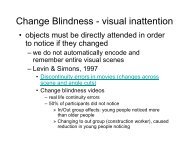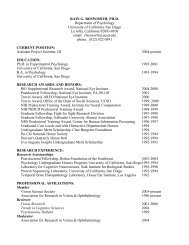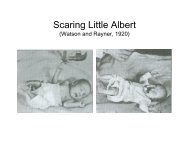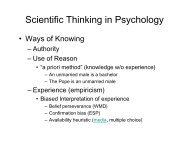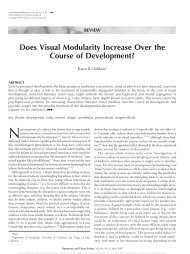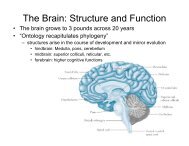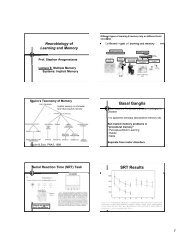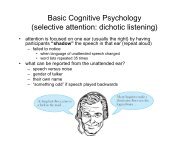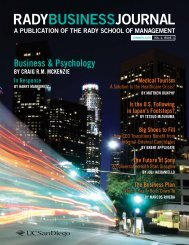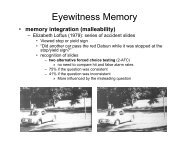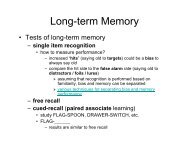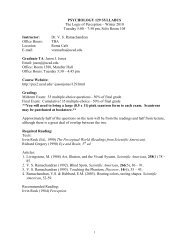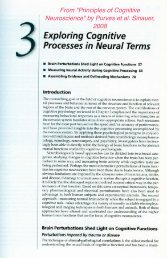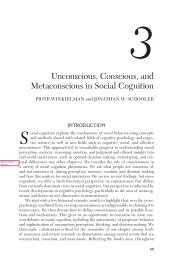Confirmation Bias: A Ubiquitous Phenomenon in Many Guises
Confirmation Bias: A Ubiquitous Phenomenon in Many Guises
Confirmation Bias: A Ubiquitous Phenomenon in Many Guises
You also want an ePaper? Increase the reach of your titles
YUMPU automatically turns print PDFs into web optimized ePapers that Google loves.
178 RAYMOND S. NICKERSON<br />
of an observation conditional on only a s<strong>in</strong>gle<br />
hypothesis, one has no way of determ<strong>in</strong><strong>in</strong>g<br />
whether the observation is diagnostic.<br />
Evidence suggests that people often do the<br />
equivalent of consider<strong>in</strong>g only p(D\H) and<br />
fail<strong>in</strong>g to take <strong>in</strong>to account the ratio of this and<br />
p(D\~H), despite the fact that consider<strong>in</strong>g only<br />
one of these probabilities does not provide a<br />
legitimate basis for assess<strong>in</strong>g the credibility of//<br />
(Beyth-Marom & Fischhoff, 1983; Doherty &<br />
Mynatt, 1986; Doherty, Mynatt, Tweney, &<br />
Schiavo, 1979; Griff<strong>in</strong> & Tversky, 1992; Kern &<br />
Doherty, 1982; Troutman & Shanteau, 1977).<br />
This tendency to focus exclusively on the case<br />
<strong>in</strong> which the hypothesis is assumed to be true is<br />
often referred to as a tendency toward pseudodiagnosticity<br />
(Doherty & Mynatt, 1986; Doherty<br />
et al., 1979; Fischhoff & Beyth-Marom, 1983;<br />
Kern & Doherty, 1982). Fischhoff and Beyth-<br />
Marom (1983) have argued that much of what<br />
has been <strong>in</strong>terpreted as a confirmation bias can<br />
be attributed to such a focus and the consequential<br />
failure to consider likelihood ratios.<br />
Preferential treatment of evidence support<strong>in</strong>g<br />
exist<strong>in</strong>g beliefs. Closely related to the restriction<br />
of attention to a favored hypothesis is the<br />
tendency to give greater weight to <strong>in</strong>formation<br />
that is supportive of exist<strong>in</strong>g beliefs or op<strong>in</strong>ions<br />
than to <strong>in</strong>formation that runs counter to them.<br />
This does not necessarily mean completely<br />
ignor<strong>in</strong>g the counter<strong>in</strong>dicative <strong>in</strong>formation but<br />
means be<strong>in</strong>g less receptive to it than to<br />
supportive <strong>in</strong>formation—more likely, for example,<br />
to seek to discredit it or to expla<strong>in</strong> it<br />
away.<br />
Preferential treatment of evidence support<strong>in</strong>g<br />
exist<strong>in</strong>g beliefs or op<strong>in</strong>ions is seen <strong>in</strong> the<br />
tendency of people to recall or produce reasons<br />
support<strong>in</strong>g the side they favor—my-side<br />
bias—on a controversial issue and not to recall<br />
or produce reasons support<strong>in</strong>g the other side<br />
(Baron, 1991, 1995; Perk<strong>in</strong>s, Allen, & Hafner,<br />
1983; Perk<strong>in</strong>s, Farady, & Bushey, 1991). It<br />
could be either that how well people remember a<br />
reason depends on whether it supports their<br />
position, or that people hold a position because<br />
they can th<strong>in</strong>k of more reasons to support it.<br />
Participants <strong>in</strong> the study by Perk<strong>in</strong>s, Farady, and<br />
Bushey were capable of generat<strong>in</strong>g reasons for<br />
hold<strong>in</strong>g a view counter to their own when<br />
explicitly asked to do so; this f<strong>in</strong>d<strong>in</strong>g led<br />
Tishman, Jay, and Perk<strong>in</strong>s (1993) to <strong>in</strong>terpret the<br />
failure to do so spontaneously as a motivational<br />
problem as dist<strong>in</strong>ct from a cognitive limitation.<br />
Baron (1995) found that, when asked to judge<br />
the quality of arguments, many people were<br />
likely to rate one-sided arguments higher than<br />
two-sided arguments, suggest<strong>in</strong>g that the bias is<br />
at least partially due to common beliefs about<br />
what makes an argument strong. In keep<strong>in</strong>g with<br />
this result, participants <strong>in</strong> a mock jury trial who<br />
tended to use evidence selectively to build one<br />
view of what happened expressed greater<br />
confidence <strong>in</strong> their decisions than did those who<br />
spontaneously tried to weigh both sides of the<br />
case (D. Kuhn, We<strong>in</strong>stock, & Flaton, 1994).<br />
When children and young adults were given<br />
evidence that was <strong>in</strong>consistent with a theory<br />
they favored, they often "either failed to<br />
acknowledge discrepant evidence or attended to<br />
it <strong>in</strong> a selective, distort<strong>in</strong>g manner. Identical<br />
evidence was <strong>in</strong>terpreted one way <strong>in</strong> relation to a<br />
favored theory and another way <strong>in</strong> relation to a<br />
theory that was not favored" (D. Kuhn, 1989, p.<br />
677). Some of Kuhn's participants were unable<br />
to <strong>in</strong>dicate what evidence would be <strong>in</strong>consistent<br />
with their theories; some were able to generate<br />
alternative theories when asked, but they did not<br />
do so spontaneously. When they were asked to<br />
recall their theories and the related evidence that<br />
had been presented, participants were likely to<br />
recall the evidence as be<strong>in</strong>g more consistent<br />
with the theories than it actually was. The<br />
greater perceived consistency was achieved<br />
sometimes by <strong>in</strong>accurate recall of theory and<br />
sometimes by <strong>in</strong>accurate recall of evidence.<br />
Look<strong>in</strong>g only or primarily for positive cases.<br />
What is considerably more surpris<strong>in</strong>g than the<br />
fact that people seek and <strong>in</strong>terpret <strong>in</strong>formation <strong>in</strong><br />
ways that <strong>in</strong>crease their confidence <strong>in</strong> favored<br />
hypotheses and established beliefs is the fact<br />
that they appear to seek confirmatory <strong>in</strong>formation<br />
even for hypotheses <strong>in</strong> whose truth value<br />
they have no vested <strong>in</strong>terest. In their pioneer<strong>in</strong>g<br />
concept-discovery experiments, Bruner, Goodnow,<br />
and Aust<strong>in</strong> (1956) found that participants<br />
often tested a hypothesized concept by choos<strong>in</strong>g<br />
only examples that would be classified as<br />
<strong>in</strong>stances of the sought-for concept if the<br />
hypothesis were correct. This strategy precludes<br />
discovery, <strong>in</strong> some cases, that an <strong>in</strong>correct<br />
hypothesis is <strong>in</strong>correct. For example, suppose<br />
the concept to be discovered is small circle and<br />
one's hypothesis is small red circle. If one tests<br />
the hypothesis by select<strong>in</strong>g only th<strong>in</strong>gs that are



